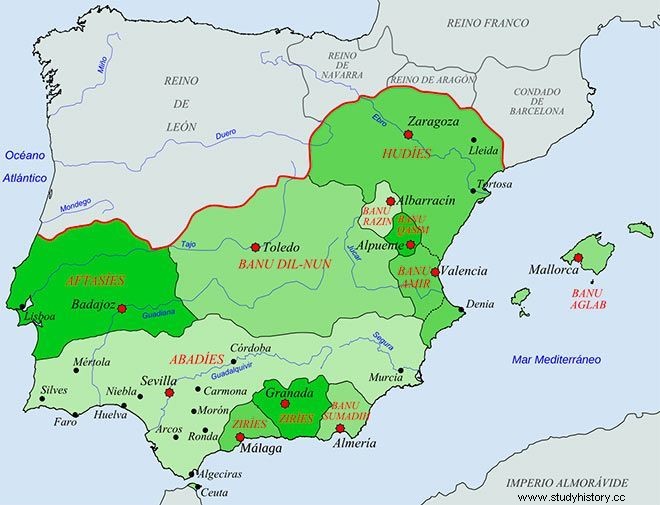From the middle of the 11th century we witness a radical change in the correlation of forces between the Christians and the Muslims of Hispania. Undoubtedly, the decomposition of al-Andalus contributed to this, as a result of the disappearance of the Caliphate of Córdoba, but also the progress that European Christianity was experiencing in general, from which they benefited, it could not be otherwise, established Christians in bull skin. Thus, the Christian nuclei in the north of the Iberian Peninsula began to take the initiative in their military attacks against al-Andalus.
The «reconquest», an expression of undoubted ideological content, since it was used to refer to the campaigns launched against the Muslims with the aim of recovering the lost lands of Spain, was underway . Before the end of the 11th century, the city of Toledo, which had been one of the most important cities in Muslim Spain since the beginning of the 8th century, was integrated into the kingdoms of Castile and León. In parallel, the Christians of eastern Hispania advanced, although with less intensity, since the Muslims, let us not forget, were still present in the Ebro valley. However, the arrival of the Almoravids, at the end of the eleventh century, on the Hispanic coming from North Africa, was a brake on the Christian offensive, while al-Andalus once again appeared united. In any case, the territory of Christian Spain not only grew in size during the eleventh century, but also witnessed important developments, ranging from the development of the towns and the bourgeoisie to the consolidation of the pilgrimage route that led to Santiago de Compostela.
Al-Andalus, Fragmented into a Mosaic of Taifa Kingdoms
Al-Andalus, once the Caliphate of Córdoba disappeared from the political scene, fragmented into a mosaic of small kingdoms, the so-called taifas , a term that means banner. At their head were in some areas the Berber leaders , in others the links , but there were also Taifas dominated by families of Arab origin. and even by muladíes . These kingdoms had a very short life, slightly more than half a century, as they were swept away before the end of the eleventh century by the invading Almoravids. The most important taifas were that of Zaragoza, where the Banu Hud ruled; that of Badajoz, which was in the hands of the Aftasíes; that of Toledo, controlled by the Banu Zennum, and, above all, those of Granada and Seville, headed by the Zirids and the Abbasids, respectively. The Taifa kinglets, in contrast to what happened in the caliphal era, were very weak from the political point of view, no matter how much they tried to imitate the model put into practice by the Umayyad rulers. Moreover, they were at the mercy of the Christian kings of Hispania, which resulted in the payment of outcasts or tributes, in exchange for which they asked for military protection. To deal with this situation, as well as to maintain the armies, basically made up of mercenaries, the Taifa leaders had no choice but to raise taxes, which led to growing discontent among the population of their domains. This situation explains why a good part of the inhabitants of al-Andalus welcomed the arrival of the Almoravids in Hispanic lands in their day.

Cultural contributions
We must not forget, however, the exceptional cultural contribution of the time of the Taifa kingdoms, characterized, among other facets, by the frequent patronage of their leaders to both writers and artists. Some monarchs even stood out in the field of literary production, such as the Sevillian al-Mu'tamid, a poet of great brilliance, or the Granada-born Abd Allah, who has left us some interesting Memoirs. It is also necessary to point out the Hebrew poet Solomon ibn Gabirol. However, the most important work in the literary field, written in times of the Taifas, is, without a doubt , The dove necklace , whose author was Ibn Hazm. The Dove Necklace , which basically consists of a passionate song of love, exerted great influence both in the Muslim world and, later, in the Christian world. In the field of history, it is necessary to mention the Muqtabis, a work of great value written by Ibn Hayyam, and in the field of geography, the works of al-'Udri and al-Bakri. With regard to astronomical knowledge, in the times of the Taifa kings, Azar-quiel achieved great fame. He was the inventor of the azafea, an instrument that replaced the astrolabe, as well as the author of some interesting astronomical tables, which were to play a great role in the future.
